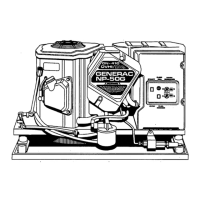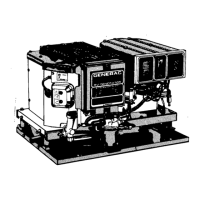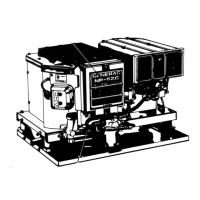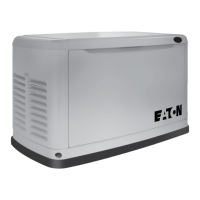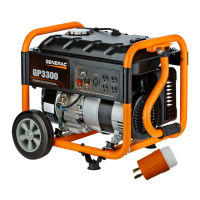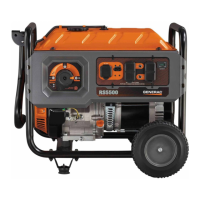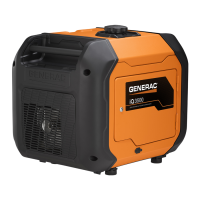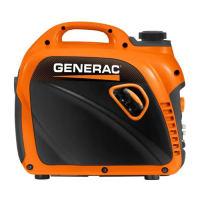•
ENGINE
EXHAUST
GAS
Before starting the generator engine,
you
should
be
sure there
is
no
way for exhaust gases
to
enter the
vehicle interior
and
endangering people or animals.
Close
windows, doors
and
other openings
in
the vehi-
cle
that,
if
open, might permit exhaust gases
to
enter
the
vehicle.
DANGER:
THE
GENERATOR
ENGINE
GIVES
OFF
DEADLY
CARBON
MONOXIDE
GAS
THROUGH
ITS
EXHAUST
SYSTEM.
THIS
DANGER·
OUS
GAS,
IF
BREATHED
IN
SUFFICIENT
CONCEN-
TRATIONS,
CAN
CAUSE
UNCONSCIOUSNESS
OR
EVEN
DEATH.
DO
NOT
OPERATE
THE
GENERA·
TOR
IF
ITS
EXHAUST
SYSTEM
IS
lEAKING
OR
HAS
BEEN
DAMAGED.
SYMPTOMS
OF
CARBON
MONOXIDE
POISONING
ARE
(A)
INABILITY
TO
THINK
COHERENTLY,
(B)
VOMITING,
(C)
TWITCH·
lNG
MUSCLES,
(D)
THROBBING
TEMPLES,
(E)
DIZZINESS,
(F)
HEADACHE,
(G)
WEA.KNESS
AND
SlEEPINESS.
IF
YOU
FEEl
ANY
OF
THESE
SYMP·
TOMS,
MOVE
INTO
FRESH
AIR
IMMEDIATELY.
IF
SYMPTOMS
PERSIST,
GET
MEDICAl
HELP.
STARTING
IMPORTANT: Read the vehicle manufacturer's
instructions. The owner/operator
should become
familiar with the vehicle
in
which this generator
is
installed. Differences exist between vehicles. For
example, some vehicles may
use
a transfer switch
to
isolate dockside power from the generator, while
other vehicles may use
an
isolating receptacle. Some
vehicles
may
be
equipped with a
DC
converter which
allows the generator to power certain
DC
lighting
and
other
DC
loads.
To
crank and start the generator engine, proceed
as
follows:
1.
Turn
OFF
electrical
loads,
using
whatever
means
provid-
ed
in
your
vehicle
(such
as
a
main
line
circuit
breaker
or
transfer
switch.
NOTE:
If
you start the engine with the start/stop
switch
on
the generator control panel, turn OFF loads
by
setting the panel's main breaker
to
the "OFF" or
"OPEN" position. Electrical load circuits will
be
turned
ON
after the generator has started, stabilized and
warmed
up.
NOTE:
You
only need
to
use
the fuel primer during
the
initial startup, after the unit
has
not been used for
an
extended period of time (two weeks) or the fuel
line
has been disconnected. The primer
is
used to
prime the
fuel pump
and
carburetor.
2.
To
crank
and
start
the
engine,
hold
the
start/stop
switch
at
START.
Release
the
switch
when
the
engine
starts.
CAUTION:
If
the
engine
does
not
start
after
it
has
been
cranking
for
15
seconds,
release
the
start/stop
switch
and
try
again.
Holding
the
switch
for
longer
than
15
seconds
may
damage
the
starter
motor.
3.
Let
the
engine
run
at
no-load
for
a
few
minutes
to
stabi-
lize
and
warm
up
the
engine.
4.
Turn
ON
electrical
loads,
using
whatever
means
provided
(such
as
a
main
circuit
breaker
or
transfer
switch).
NOTE:
If
you start a warm generator engine, you
maY.
press
the
start switch only slightly to engage the
1gmt1on
system. However,
you
should press and
hold
the starter switch for a minimum
of
two
(2)
seconds
to
energize the field boost system. If you start the
engine without energizing the
field boost system, the
generator produces
no
AC
output.
STOPPING
THE
GENERATOR
1.
Turn
OFF
all
electrical
loads,
using
whatever
means
pro-
vided
(such
a
main
circuit
breaker
or
transfer
switch).
2.
Let
the
generator
run
at
no-load
for
a
few
minutes,
to
sta-
bilize
internal
engine-generator
temperatures.
3.
Place
Start/Stop
switch
in
its
STOP
position.
APPLYING
LOADS
TO
GENERATOR
When applying .electrical loads to the generator,
observe these
gUidelines:
•
Before
applying
electrical
loads,
let
the
generator
stabilize
and
warm
up
for
a
minute
or
two.
•
DO
NOT
overload
the
generator.
•
LETTING
ENGINE
STABILIZE
The generator supplies correct rated frequency and
volta~e
only
~t
the proper governed speed. Some
electncal appliances
may be extremely sensitive
to
voltage
and
frequency. Incorrect frequencies and/or
voltages
can
damage those appliances.
If electrical loads
are applied at reduced operating
~p~eds,
such
.loads
imp.osed
on
the engine when suf-
ficient power
IS
not available may shorten engine life.
Never
~urn
ON
electrical loads until after the genera-
tor engme
has
started
and
stabilized ON-speed.
ATTENTION
REQUIRED
AFTER
SUBMERSION
If
the
~otor
home generator
has
been submerged
in
water,
It
mu~t
N9T
be
started or operated. Following
any submersion m
water,
have
an
authorized Generac
Service Facility thoroughly
clean
and
dry
the
generator.
OPERATION
IN
HIGH
GRASS
OR
BRUSH
Never operate the generator while the vehicle
is
parked
in
high grass, weeds, brush or leaves. Such
materials
can ignite and burn from the heat of the
exhaust system. The generator exhaust system
becomes
extremely hot during operation
and
remains
hot for a
long
time after
it
has shut down.
OPERATING
PRECAUTIONS
Never operate the motor home generator set while
the vehicle
is
parked over dry leaves, dry grass or
any other
combustible substance. The generator's
exhau~t
s_y~t~m
becomes extremely got and can
cause
f1re
1f 1t
1s
too close to combustible materials.
-6-

